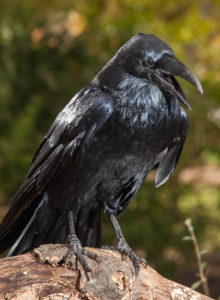Common Raven
Common Raven
Corvus corax
Birds in the Family Corvidea (ravens, crows, jays) are believed to be among the most intelligent birds. The brain to body ratio of corvids is the largest of any bird and only slightly less than humans. Ravens in particular show ingenuity in feeding strategies, use of tools, and cooperative group behaviors. Ravens learn by exploring their environment and then pass this “knowledge” to next generations.
Raven or Crow?
Common Ravens are much larger than crows. In fact, they are the largest all-black bird in the world. Ravens have a wedge-shaped tail which can be seen in flight. Ravens also prefer open landscapes with less human activity while crows will congregate in urban areas and can be seen in neighbors and local parks.
Ravens have long been part of human folklore. Believed to be very intelligent animals, with a trickster-like personality, they have been both feared and revered. Because they will eat carrion (dead animals), some cultures dreaded ravens as messengers of ill-will and death. Others, however, recognized and admired their cleverness. Many Native American traditional stories portray Raven as the creator of humans.
Ravens are also acrobatic fliers, displaying aerial rolls, somersaults, and even flying upside down.
They are social and have a diverse range of calls, non-vocal sounds, and physical displays to communicate with one another.
Our resident raven, Hello, says “hello” in several different voices and mimics several animal sounds. In 1999, he was found thin and dehydrated and brought into Lindsay Wildlife hospital. It was discovered that he had permanent neurological issues and impaired vision, preventing him from fending for himself in the wild. Because Hello is unable to fly, keepers take him on walks on the glove throughout our exhibit hall and even out to the Raptor Redwood Grove! One of his favorite pastimes is joining the animal keepers for their weekly meeting in the Nature Cove.

